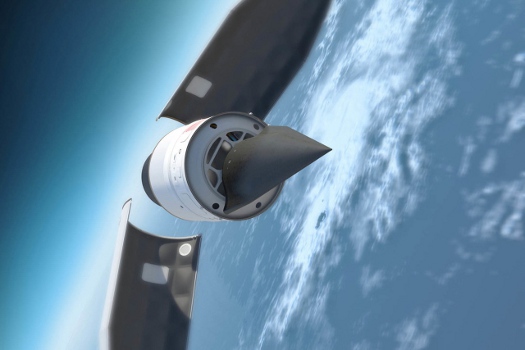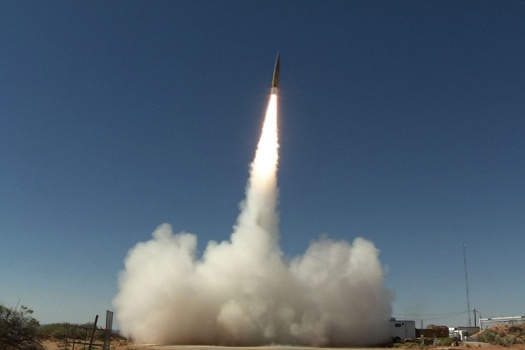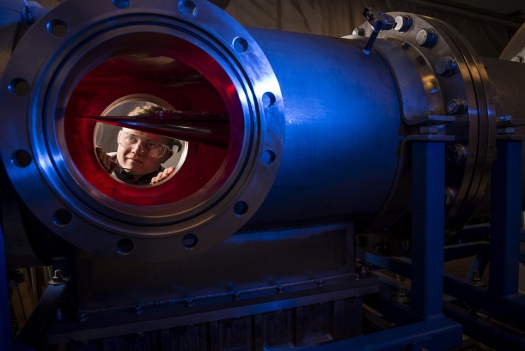 |
| October 15, 2019 | Volume 15 Issue 39 |
Designfax weekly eMagazine
Archives
Partners
Manufacturing Center
Product Spotlight
Modern Applications News
Metalworking Ideas For
Today's Job Shops
Tooling and Production
Strategies for large
metalworking plants
Sensors for hypersonics a top DOD priority

The Defense Advanced Research Products Agency's Falcon Hypersonic Test Vehicle emerges from its rocket nose cone and prepares to re-enter the Earth's atmosphere. [Credit: DoD illustration]
By C. Todd Lopez
A hypersonic weapon moving at five times the speed of sound can travel across the Pacific Ocean in just over 100 minutes.
U.S. adversaries are developing such weapons now, said Michael D. Griffin, undersecretary of defense for research and engineering.
"They are quite capable," Griffin said. "The advantage offered by a hypersonic offense is that it overflies air defenses as we understand them today, and it underflies our missile defenses. It goes into the gap between air defense and missile defense."

A Sabre short-range ballistic missile launches in June 7, 2017, at White Sands Missile Range, NM, for a test of the Patriot Advanced Capability-3 Missile Segment Enhancement, an advanced missile defense system. [Credit: U.S. Army photo]
Speaking during a discussion at the Hudson Institute in Washington on August 13, Griffin told Hudson Institute Senior Fellow Rebeccah L. Heinrichs that hypersonic threats move so fast they're almost too fast to stop.
"By the time we can see it on defensive radar systems, it's nearly too late to close the kill chain," he said. "It would be difficult to close that kill chain for one threat. But in a raid scenario, you just can't get there from here ... so we have to see them coming from further out."
Detecting the threat from hypersonics in enough time to neutralize, Griffin said, will require new detection systems in low Earth orbit.
"We need a proliferated layer of sensors, because we can't see these things from a few spacecraft in geostationary orbit," he said. "So the requirement leads you to a proliferated sensor layer in relatively much lower orbit."

Air Force Cadet 2nd Class Eric Hembling uses a Ludwieg Tube to measure the pressures, temperatures, and flow field of various basic geometric and hypersonic research vehicles at Mach 6 in the U.S. Air Force Academy's Department of Aeronautics, Jan. 31, 2019. [Photo: Joshua Armstrong, U.S. Air Force]
Griffin said it's the Missile Defense Agency where the Hypersonic and Ballistic Tracking Space Sensor will be developed.
Connecting those sensors together into a network, he said, is a separate problem being developed at the Space Development Agency. He described what they've been asked to do as "a resilient, highly proliferated mesh network communications system in low Earth orbit ... similar to what you see commercial companies talking about for LEO broadband."
That communications layer, he said, is central to hypersonic defense.
"The sensor layer is critical, but if it can't talk among itself, it will not be effective," Griffin said. "The ability to communicate underlays every other layer we wish to deploy, whether it is for space situational awareness, or hypersonic threat detection and tracking, or maritime domain awareness, or whatever. Whatever other functions we want, they are enabled first by the ability to communicate in a resilient fashion, which we don't have today."
Hypersonic defense, he said, is not limited to just the Missile Defense Agency and the Space Development Agency. It's an across-DOD effort that touches nearly everything.
"It touches space, it touches ground stations, it touches detection and tracking algorithms, and fire control algorithms," the undersecretary said. "Dealing with the hypersonic threat is even more of an interdisciplinary and multidisciplinary problem than ground missile defense was."
Source: Department of Defense
Published October 2019
Rate this article
View our terms of use and privacy policy
